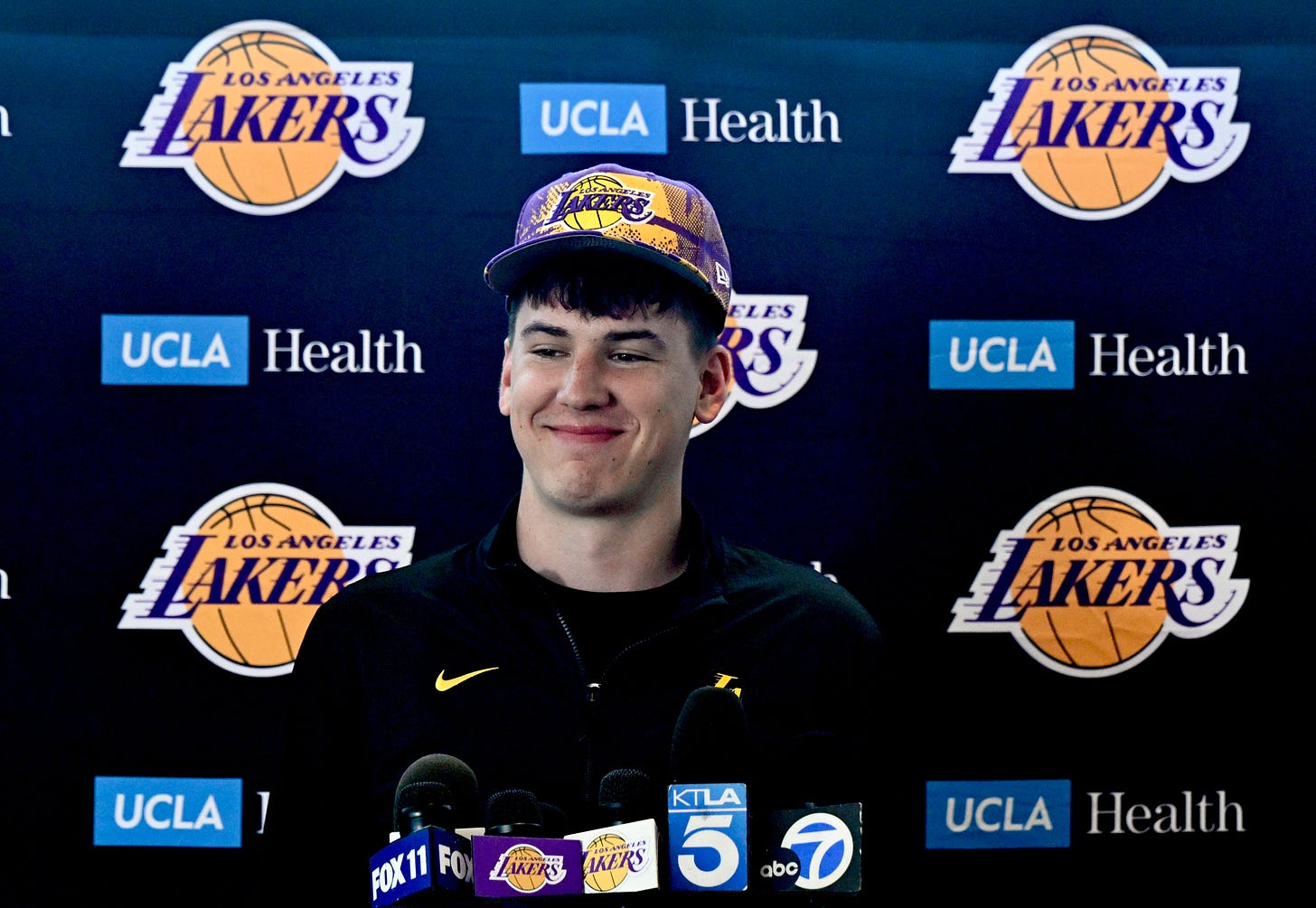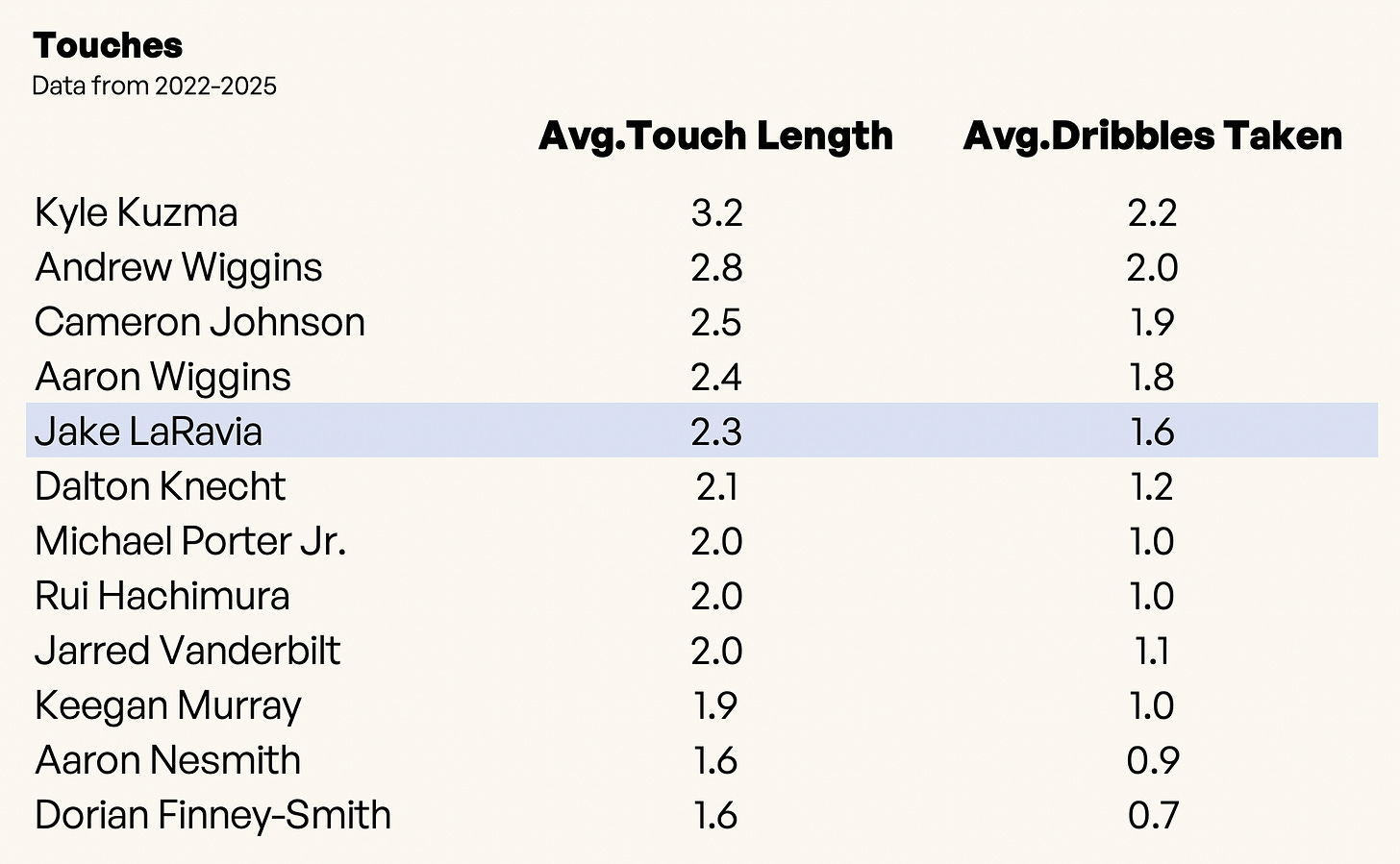The Intriguing Case of Jake LaRavia and the Connector Archetype
Data deep-dive and other observations on the Lakers’ new wing addition
Deandre Ayton was the biggest and most important Lakers offseason addition (in case you missed my deep-dive on the new starting center, you can find it here). The hole in the middle was the most pressing and obvious need to address, and Ayton’s arrival gave the team both time and flexibility to rebuild the roster around Luka Dončić.
But to create the cap space for that move, the Lakers let go of Dorian Finney-Smith—whether by choice or misstep—who eventually signed with Houston. With some of the remaining cap space, they signed 23-year-old forward Jake LaRavia. The timing was curious: LaRavia was the first offseason signing Rob Pelinka made, and it wasn’t the profile many expected. He’s not the wing stopper or point-of-attack defender this roster still sorely lacks—a role the front office will still have to fill using assets they preserved by not spending them on a center.
LaRavia might still fill a role and provide a skillset that wasn’t as glaringly missing in the playoffs as the lack of size or perimeter defense, but it was still a gap that hurt the Lakers when games tightened down the stretch against Minnesota.
Breakdown highlights
The connector
Data breakdown and comparison to 11 other similar wing players 📊
Finishing on drives and self-created shots 📈
Defensive gap filler
Look at the past, to predict the future?
1–The connector
The lack of size was the primary reason the Lakers collapsed in the first round against the Timberwolves. Heavy minutes from undersized, small-ball lineups took a toll as the series wore on, and by the closeout game, Rudy Gobert was feasting on the glass. But size wasn’t the only issue. The Lakers also struggled to score. Without a big who could operate as a true pick-and-roll partner, Luka Dončić was left attacking switches in isolation far too often. Beyond that, the roster lacked versatility. Dorian Finney-Smith and Rui Hachimura offered spot-up shooting but little else off the bounce. Jarred Vanderbilt brought defense but very limited, or rather no offense. What the Lakers needed was one or two players who could do a bit of everything—someone who could shoot, attack a closeout, keep the advantage alive with a drive and kick, rebound, and defend well enough to stay on the floor. A connector.
It’s the same word Jake LaRavia used twice during his introductory press conference to describe his own game. And it’s the word those who’ve watched him closely often come back to.
2–Data breakdown and comparison to 11 other similar wing players 📊
LaRavia also talked about himself as a high-IQ player, one who could get into the paint and make the right reads and plays for his teammates last season. Adam Pike, a great follow for Memphis Grizzlies game film and X&O breakdowns, described him to me as a good decision-maker. One other league observer used the words really good off the catch and handoff timing, and a good connective passer.
Watching LaRavia on film, it’s clear he’s not just a standstill, spot-up shooter—he’s a player who can do a little bit of everything. But how versatile is his game really, and does that show up in the advanced offensive numbers? To explore that, I compared LaRavia to a group of similar wing archetypes: players known primarily as shooters, but who can also offer something beyond that. I also added Finney-Smith, Hachimura, Vanderbilt, and Dalton Knecht to see how LaRavia stacks up against recent Lakers forwards.
Shooting is always the first thing to evaluate when looking at a player’s fit next to Dončić, James, and Reaves—three players who constantly attack the paint and collapse the defense. LaRavia had a breakout year from beyond the arc last season, hitting 42 percent of his threes. However, as he noted in his introductory press conference, the volume needs to increase. Compared to some of the more willing shooters in this comparison group, LaRavia’s three-point attempts per 100 possessions remain on the lower end (similar to Hachimura in that regard). However, percentage of self-created threes shows he’s more capable of pulling up off the dribble than some of the catch-and-shoot-only options on the list, like Finney-Smith or Hachimura. So potential for growth is definatelly there.
Attacking close-outs is the next thing to look for in a connective wing, and both average touch time and dribbles per touch place LaRavia closer to players like Kyle Kuzma or Cameron Johnson—wings who can do more off the bounce—rather than the more limited, spot-up archetype of Finney-Smith or Hachimura. Watching LaRavia’s film, it’s clear that faking the three and attacking closeouts off the dribble is often his preferred move—something reflected in his relatively low three-point volume and above-average drive, touch time, and dribble numbers compared to others in the comparison group.
Passing is where LaRavia’s connective and unselfish DNA really stands out. He ranks at the top of this group in passes per 100 possessions and in passes that lead to a shot—numbers that clearly separate him from play-finisher-only types like Hachimura, who sits at the bottom of the list. To beat the best NBA defenses, multiple efforts, drive-and-kicks, or side-to-side swings are often required. Having a non-star player who can keep the advantage alive is becoming increasingly valuable.
Passing and making decisions on the move comes at a cost, one of LaRavia’s weaknesses so far in his career has been a high turnover rate.
3-Finishing on drives and self-created shots 📈
Keep reading with a 7-day free trial
Subscribe to digginbasketball to keep reading this post and get 7 days of free access to the full post archives.









